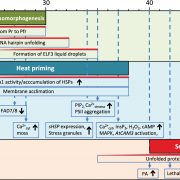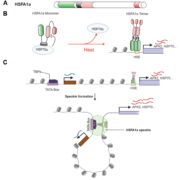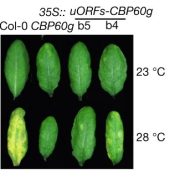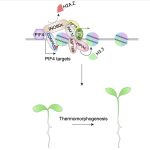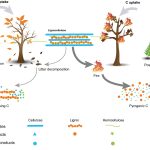Review: Temperature sensing in plants
 Like all organisms, plants respond to changes in temperature by activating pathways that enable them to stay alive in spite of rising or lowering temperatures. Interestingly though, there is no universal temperature sensing mechanism across the domains of life. Changes in membrane fluidity (think of melting butter) are common sensors, as are rates of reactions (cooler = slower) or protein or RNA conformation (with added heat destabilizing hydrogen bonds). This excellent review by Kerbler and Wigge describes four well-characterized temperature response pathways, and evidence for various thermal sensors. The described pathways include the vernalization pathway (through which prolonged cold temperatures confers flowering competence), cold stress responses, heat shock responses, and thermomorphogenesis in which growth patterns are altered by elevated temperatures. The sensors or signal integrators discussed include several membrane-localized proteins that respond to changes in membrane fluidity, thermal reversion of phytochrome (the rate at which Pfr reverts back to Pr, which is highly temperature dependent), phase separation and biomolecular condensates, and the presence of the histone variant H2A.Z in nucleosomes. Temperature signaling through transcription, splicing, and protein turnover is also discussed. This interesting and accessible review also poses the question of whether studies on temperature sensing in plants can be leveraged to engineer greater thermal resilience into crop plants. Wouldn’t that be interesting! (Summary by Mary Williams @PlantTeaching) Annu. Rev. Plant Biol. 10.1146/annurev-arplant-102820-102235
Like all organisms, plants respond to changes in temperature by activating pathways that enable them to stay alive in spite of rising or lowering temperatures. Interestingly though, there is no universal temperature sensing mechanism across the domains of life. Changes in membrane fluidity (think of melting butter) are common sensors, as are rates of reactions (cooler = slower) or protein or RNA conformation (with added heat destabilizing hydrogen bonds). This excellent review by Kerbler and Wigge describes four well-characterized temperature response pathways, and evidence for various thermal sensors. The described pathways include the vernalization pathway (through which prolonged cold temperatures confers flowering competence), cold stress responses, heat shock responses, and thermomorphogenesis in which growth patterns are altered by elevated temperatures. The sensors or signal integrators discussed include several membrane-localized proteins that respond to changes in membrane fluidity, thermal reversion of phytochrome (the rate at which Pfr reverts back to Pr, which is highly temperature dependent), phase separation and biomolecular condensates, and the presence of the histone variant H2A.Z in nucleosomes. Temperature signaling through transcription, splicing, and protein turnover is also discussed. This interesting and accessible review also poses the question of whether studies on temperature sensing in plants can be leveraged to engineer greater thermal resilience into crop plants. Wouldn’t that be interesting! (Summary by Mary Williams @PlantTeaching) Annu. Rev. Plant Biol. 10.1146/annurev-arplant-102820-102235



